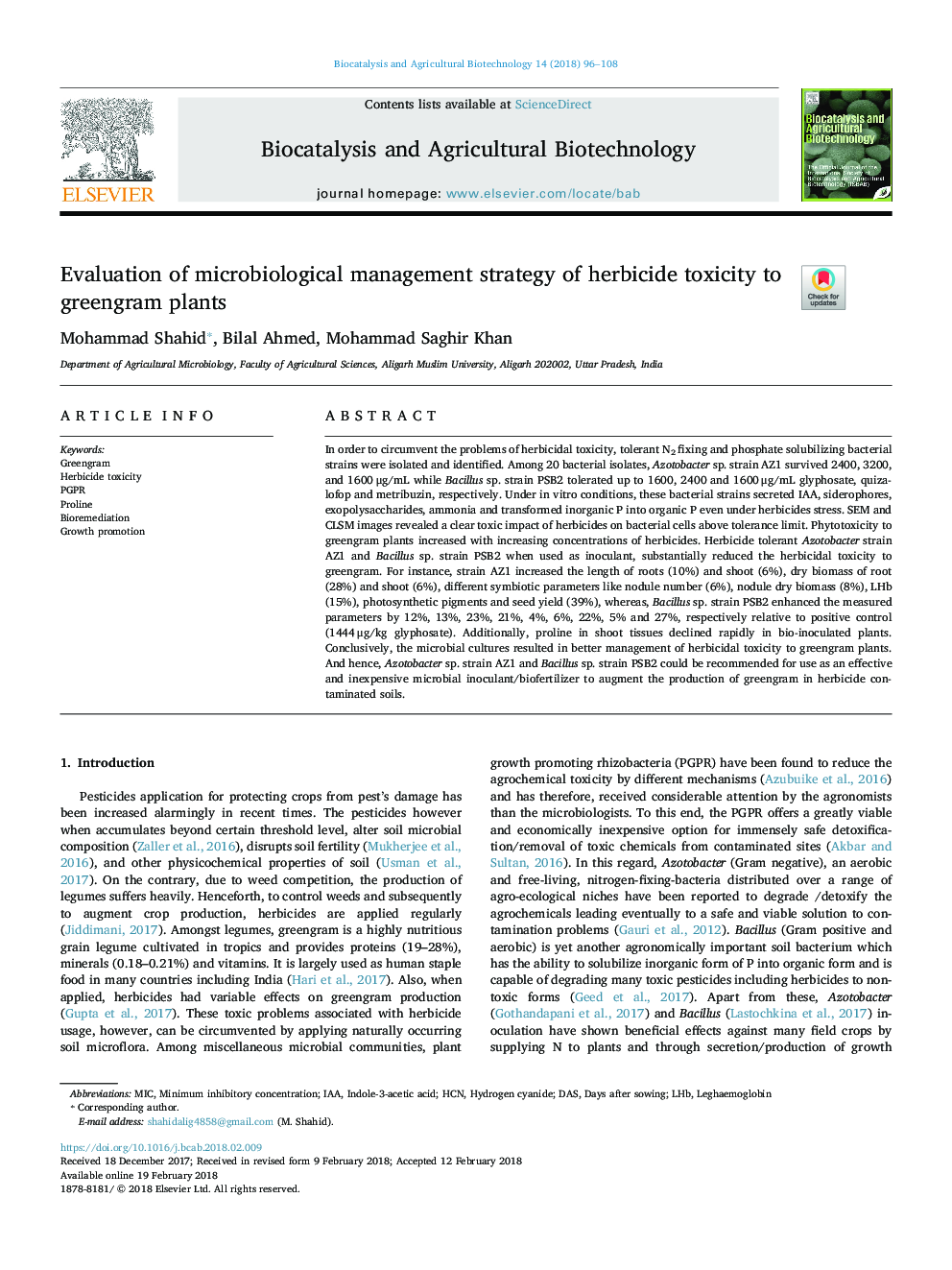| کد مقاله | کد نشریه | سال انتشار | مقاله انگلیسی | نسخه تمام متن |
|---|---|---|---|---|
| 8406128 | 1544898 | 2018 | 13 صفحه PDF | دانلود رایگان |
عنوان انگلیسی مقاله ISI
Evaluation of microbiological management strategy of herbicide toxicity to greengram plants
ترجمه فارسی عنوان
ارزیابی استراتژی مدیریت میکروبیولوژی سمیت علف کش به گیاهان سبز
دانلود مقاله + سفارش ترجمه
دانلود مقاله ISI انگلیسی
رایگان برای ایرانیان
کلمات کلیدی
موضوعات مرتبط
علوم زیستی و بیوفناوری
علوم کشاورزی و بیولوژیک
علوم کشاورزی و بیولوژیک (عمومی)
چکیده انگلیسی
In order to circumvent the problems of herbicidal toxicity, tolerant N2 fixing and phosphate solubilizing bacterial strains were isolated and identified. Among 20 bacterial isolates, Azotobacter sp. strain AZ1 survived 2400, 3200, and 1600â¯Î¼g/mL while Bacillus sp. strain PSB2 tolerated up to 1600, 2400 and 1600â¯Î¼g/mL glyphosate, quizalofop and metribuzin, respectively. Under in vitro conditions, these bacterial strains secreted IAA, siderophores, exopolysaccharides, ammonia and transformed inorganic P into organic P even under herbicides stress. SEM and CLSM images revealed a clear toxic impact of herbicides on bacterial cells above tolerance limit. Phytotoxicity to greengram plants increased with increasing concentrations of herbicides. Herbicide tolerant Azotobacter strain AZ1 and Bacillus sp. strain PSB2 when used as inoculant, substantially reduced the herbicidal toxicity to greengram. For instance, strain AZ1 increased the length of roots (10%) and shoot (6%), dry biomass of root (28%) and shoot (6%), different symbiotic parameters like nodule number (6%), nodule dry biomass (8%), LHb (15%), photosynthetic pigments and seed yield (39%), whereas, Bacillus sp. strain PSB2 enhanced the measured parameters by 12%, 13%, 23%, 21%, 4%, 6%, 22%, 5% and 27%, respectively relative to positive control (1444â¯Î¼g/kg glyphosate). Additionally, proline in shoot tissues declined rapidly in bio-inoculated plants. Conclusively, the microbial cultures resulted in better management of herbicidal toxicity to greengram plants. And hence, Azotobacter sp. strain AZ1 and Bacillus sp. strain PSB2 could be recommended for use as an effective and inexpensive microbial inoculant/biofertilizer to augment the production of greengram in herbicide contaminated soils.
ناشر
Database: Elsevier - ScienceDirect (ساینس دایرکت)
Journal: Biocatalysis and Agricultural Biotechnology - Volume 14, April 2018, Pages 96-108
Journal: Biocatalysis and Agricultural Biotechnology - Volume 14, April 2018, Pages 96-108
نویسندگان
Mohammad Shahid, Bilal Ahmed, Mohammad Saghir Khan,
